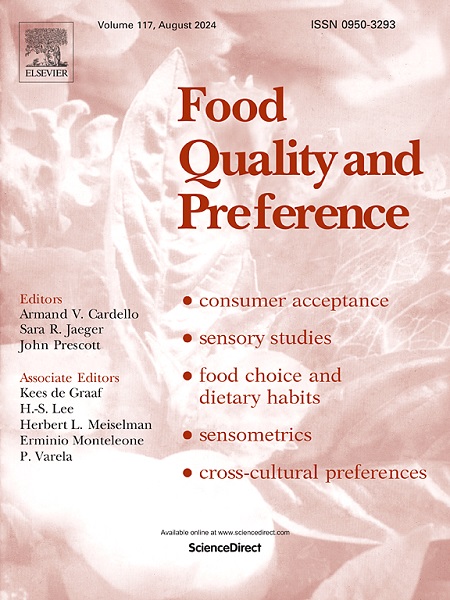Analysing TCATA citation proportions as a tool to optimise temporal vocabulary selection: a case study of whey protein model beverages
IF 4.9
1区 农林科学
Q1 FOOD SCIENCE & TECHNOLOGY
引用次数: 0
Abstract
Sequential profiling is used to assess the temporal variability of attribute intensity perception with repeated consumption; this is insightful for attributes which build-up with repeated consumption, such as mouthdrying in whey protein beverages. It is common for researchers to select attributes for use in sequential tests from the vocabulary lists of descriptive sensory profiling with limited justification being provided. It was hypothesised that Temporal Check All That Apply (TCATA) can be used as an effective and objective technique to select relevant vocabulary. This was investigated using model whey protein beverages containing 10 % whey protein isolate powder with a trained sensory panel and comparing the proportion of citations at regular time intervals across the assessment window. The proportion of panellists selecting an attribute was used to represent panel confidence in the attribute's applicability. Using a consensus vocabulary for TCATA, mouthdrying was selected by 58 % of panellists at 30 s and 71 % at 60 s relative to consumption, identifying this attribute as relevant for temporal investigations. Sweetness was selected by fewer than 10 % of panellists throughout the assessment window. In sequential profiling, mouthdrying significantly increased over time whereas sweetness did not, confirming TCATA as an effective vocabulary selector in this context. The results demonstrate that TCATA can be used to ensure the unbiased selection of relevant attributes to be investigated in subsequent temporal intensity methods. The use of citation proportions can elucidate additional information from TCATA data surrounding the applicability of attributes and panel confidence.

分析TCATA引用比例作为优化时态词汇选择的工具:乳清蛋白模型饮料的案例研究
采用序列分析方法对重复消费下属性强度感知的时间变异性进行了评价;这是深刻的属性,积累与反复消费,如在乳清蛋白饮料的口干舌燥。这是常见的研究人员选择属性用于顺序测试从词汇表的描述性感官剖析有限的理由被提供。本研究假设TCATA (Temporal Check All that Apply)是一种有效而客观的词汇选择方法。研究人员使用含有10%乳清分离蛋白粉的乳清蛋白模型饮料和训练过的感官面板进行了调查,并在评估窗口的固定时间间隔内比较了引用的比例。小组成员选择属性的比例用于表示小组对属性适用性的置信度。使用TCATA的共识词汇,相对于消费,58%的30岁小组成员和71%的60岁小组成员选择了干口,确定了这一属性与时间调查相关。在整个评估窗口中,只有不到10%的小组成员选择了甜味。在连续分析中,干口度随时间显著增加,而甜味则没有,这证实了TCATA在这种情况下是有效的词汇选择器。结果表明,TCATA可以确保在后续的时间强度方法中研究的相关属性的无偏选择。引用比例的使用可以阐明TCATA数据中关于属性适用性和小组置信度的附加信息。
本文章由计算机程序翻译,如有差异,请以英文原文为准。
求助全文
约1分钟内获得全文
求助全文
来源期刊

Food Quality and Preference
工程技术-食品科技
CiteScore
10.40
自引率
15.10%
发文量
263
审稿时长
38 days
期刊介绍:
Food Quality and Preference is a journal devoted to sensory, consumer and behavioural research in food and non-food products. It publishes original research, critical reviews, and short communications in sensory and consumer science, and sensometrics. In addition, the journal publishes special invited issues on important timely topics and from relevant conferences. These are aimed at bridging the gap between research and application, bringing together authors and readers in consumer and market research, sensory science, sensometrics and sensory evaluation, nutrition and food choice, as well as food research, product development and sensory quality assurance. Submissions to Food Quality and Preference are limited to papers that include some form of human measurement; papers that are limited to physical/chemical measures or the routine application of sensory, consumer or econometric analysis will not be considered unless they specifically make a novel scientific contribution in line with the journal''s coverage as outlined below.
 求助内容:
求助内容: 应助结果提醒方式:
应助结果提醒方式:


